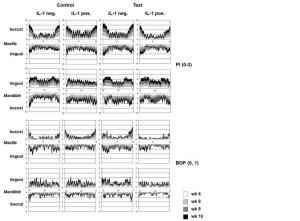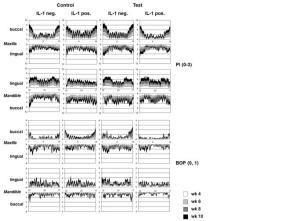Tagged: bleeding on probing
On the Level of Periodontal Care in US American Studies
The large multi-center intervention trial by Engebretson et al. (2013), who had reported lack of any effect of non-surgical periodontal therapy on HbA1c levels in type 2 diabetes mellitus patients after 3 and 6 months, has been harshly criticized because of very moderate clinical improvements as regards pocket depth reduction (from mean 3.26 mm at baseline) of 0.4 mm (95% CI 0.4; 0.5 mm) and reduction of bleeding on probing (from mean 62%) of 19% (95% CI 15.7; 22.4). What was even more concerning was that, 6 months after seemingly intense treatment (at least 160 minutes of scaling and root planing followed by oral hygiene instruction and, for two weeks, twice daily mouthwash with 0.12% clorhexidine digluconate; then, at both 3- and 6-month follow-up examinations, further oral hygiene instructions and scaling/root planing for another hour), bleeding on probing was still seen at an average of 40% sites while, on average, 70% tooth surfaces were still covered by plaque (from 86% at baseline).
These are undeniable problems of the study. Claims that periodontal treatment was insufficient and, as a consequence, periodontal infection still present in most patients after periodontal therapy, may in fact be justified. It is the sheer size of the attack which is so appalling. Each and every editor of our professional journals and numerous further pundits, altogether 21, had joined, well, the public execution of the study’s principle investigator. Because of unwelcome results of a study with the potential of ending a story, or illusion, once and forever. And, absolutely inappropriate attempts of intimidation of scientists when writing,
“Given the inconlusive nature of these data, we recommend that the existing body of evidence in which meta-analyses consistently conclude that successful periodontal therapy appears to improve glycemic control, should instruct us until results from future studies are reported. We urge all interested parties to refrain from using this study results as a basis for future scientific texts, new research projects, guidelines, policies, and advice regarding the incorporation of necessary periodontal treatment in diabetes management.” (Emphasis added.)
So, censorship. This is absolutely unscientific. Meta-analyses are always preliminary and must incorporate new results on a continuous basis.
Multilevel Modeling of Periodontal Data (VI)
Graphic display of results of a randomized clinical trial may lead to interesting hypotheses which might be tested with more sophisticated statistical methods. In a steady-state plaque environment, the topographical distribution of plaque, as assessed by Silness & Löe’s plaque index, in subjects using triclosan-containing test toothpaste for 6 weeks (after a 4 week preparatory phase) or fluoride control toothpaste is shown in the upper two panels. Results in IL-1 genotype-positive and -negative subjects are differentiated. While plaque distribution was largely comparable, consistent (mean plaque index scores of each examination were displayed on top of each other) and symmetric and followed a distinct pattern; bleeding on probing (a binary response), which is shown in the lower two panels, was not consistent, not symmetric and did not really follow a distinct pattern. Prevalence of bleeding on probing in the two most right panels (Il-1 genotype positive test toothpaste users) seems to differ from the other groups. The procedures described in the following chapter of my manual may indeed allow modeling of site-specific bleeding on probing.
6 Repeated Measures Models for Binary Outcomes
In Chapter 3, we had described simple, and quite complex, repeated measures time series models in which continuous outcomes, for instance, gingival thickness or gingival recession, were modeled over time after the implantation of a bio-resorbable membrane, when it had to be assumed that the responses were non-linear and non-monotonic.
In this chapter we want to model the binary outcome, bleeding on gingival probing, in subjects with mild plaque-induced gingival disease over time. While participants of the 1999 Workshop on Periodontal Diseases and Conditions had realized that most gingival inflammation is indeed dental plaque-induced, there seem to be numerous intrinsic and extrinsic factors which may modify the response. For instance, a common toothpaste compound, Triclosan, seems to dampen gingival inflammation in the presence of dental plaque (Müller et al. 2006). One may also ask whether the so-called interleukin-1 genotype, a combination of two single polymorphisms in the IL-1 gene, i.e. a haplotype, which had been associated with increased susceptibility for destructive periodontal disease (Kornman et al.1997) has a clinically discernable influence on the inflammatory response on dental plaque.
Mirrored from Periodontology – Matters arising.
Multilevel Modeling of Periodontal Data (VI)
 Graphic display of results of a randomized clinical trial may lead to interesting hypotheses which might be tested with more sophisticated statistical methods. In a steady-state plaque environment, the topographical distribution of plaque, as assessed by Silness & Löe’s plaque index, in subjects using triclosan-containing test toothpaste for 6 weeks (after a 4 week preparatory phase) or fluoride control toothpaste is shown in the upper two panels. Results in IL-1 genotype-positive and -negative subjects are differentiated. While plaque distribution was largely comparable, consistent (mean plaque index scores of each examination were displayed on top of each other) and symmetric and followed a distinct pattern; bleeding on probing (a binary response), which is shown in the lower two panels, was not consistent, not symmetric and did not really follow a distinct pattern. Prevalence of bleeding on probing in the two most right panels (Il-1 genotype positive test toothpaste users) seems to differ from the other groups. The procedures described in the following chapter of my manual may indeed allow modeling of site-specific bleeding on probing.
Graphic display of results of a randomized clinical trial may lead to interesting hypotheses which might be tested with more sophisticated statistical methods. In a steady-state plaque environment, the topographical distribution of plaque, as assessed by Silness & Löe’s plaque index, in subjects using triclosan-containing test toothpaste for 6 weeks (after a 4 week preparatory phase) or fluoride control toothpaste is shown in the upper two panels. Results in IL-1 genotype-positive and -negative subjects are differentiated. While plaque distribution was largely comparable, consistent (mean plaque index scores of each examination were displayed on top of each other) and symmetric and followed a distinct pattern; bleeding on probing (a binary response), which is shown in the lower two panels, was not consistent, not symmetric and did not really follow a distinct pattern. Prevalence of bleeding on probing in the two most right panels (Il-1 genotype positive test toothpaste users) seems to differ from the other groups. The procedures described in the following chapter of my manual may indeed allow modeling of site-specific bleeding on probing.
6 Repeated Measures Models for Binary Outcomes
In Chapter 3, we had described simple, and quite complex, repeated measures time series models in which continuous outcomes, for instance, gingival thickness or gingival recession, were modeled over time after the implantation of a bio-resorbable membrane, when it had to be assumed that the responses were non-linear and non-monotonic.
In this chapter we want to model the binary outcome, bleeding on gingival probing, in subjects with mild plaque-induced gingival disease over time. While participants of the 1999 Workshop on Periodontal Diseases and Conditions had realized that most gingival inflammation is indeed dental plaque-induced, there seem to be numerous intrinsic and extrinsic factors which may modify the response. For instance, a common toothpaste compound, Triclosan, seems to dampen gingival inflammation in the presence of dental plaque (Müller et al. 2006). One may also ask whether the so-called interleukin-1 genotype, a combination of two single polymorphisms in the IL-1 gene, i.e. a haplotype, which had been associated with increased susceptibility for destructive periodontal disease (Kornman et al.1997) has a clinically discernable influence on the inflammatory response on dental plaque.
22 December 2014 @ 1:10 pm.
Last modified December 22, 2014.
